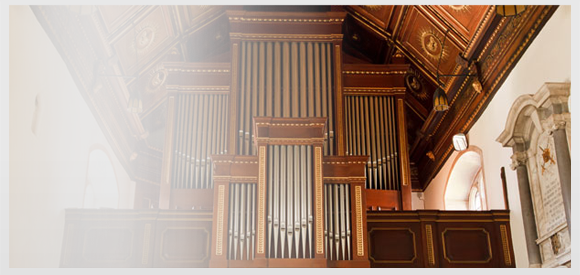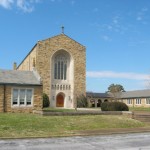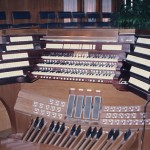First Cumberland Presbyterian Church
Around 1875, the Cumberland Presbyterians built their $20,000 church at the corner of Oak and Lindsay. Nothing is known about early organs in the church until a John Brown organ was moved to the church from a church in Griffin GA. The move was done by Pilcher, who rebuilt the 9-rank organ and added 7 ranks to it as their Op. 1767. In 1958 the congregation sold the property to nearby First Baptist Church and moved to the Brainerd area near the intersection of North Moore and Shallowford Roads.
The first part of the impressive new facility to be built was the south wing, containing classrooms, offices and a fellowship hall, where services were held until the rest of the church plant was built. The sanctuary and north wing were completed in 1963. All of the buildings except for the sanctuary are single-story in order to give an even great sense of height to the soaring sanctuary. The height of the sanctuary from floor to ceiling is 54 feet, and the nave is over 150 long and 50 feet wide, with seating for over 1,200.
The exterior is of Tennessee Quartzite, commonly known as Crab Orchard stone. The ceiling murals were painted by 78-year old Hugh Tyler over a period of three months. The cross beams are painted an attractive gold and pale blue. The grand and beautiful look of the sanctuary has made it a favorite venue for weddings in Chattanooga.
An two-manual Allen C-3 organ was purchased when the church moved to Brainerd. It was moved into the sanctuary when it was completed, where it served until the Ruffatti was installed in 1981. The Ruffatti is installed on the front wall to each side of the tall chancel stained-glass window. The Swell and Choir-Postiiv are installed in a chamber high on the north wall of the chancel. The 23 equivalent electronic ranks are by Rodgers; the Grand Choeur, to be installed in the gallery, is prepared for. The hard ceiling and the slate floor make for an excellent acoustic.
Fratelli Ruffatti, 1981, 3/49
| GREAT | SWELL | CHOIR-POSITIV | ||||||
| 16′ | Spitzflote | 1-12 elec | 16′ | Bourdon Doux | elec | 16′ | Erzahler | elec |
| 8′ | Principal | 8′ | Bourdon | 8′ | Singendgedeckt | |||
| 8′ | Spitzflote | 8′ | Viola Pomposa | 8′ | Flauto Mirabilis | elec | ||
| 4′ | Prestant | 8′ | Viola Celeste | 8′ | Gamba | elec | ||
| 4′ | Flute Harmonique | 8′ | Flute Celeste II | 8′ | Gamba Celeste | elec | ||
| 2′ | Doublette | 4′ | Prestant | 12 | 8′ | Erzahler | elec | |
| IV-VI | Fourniture | 4′ | Flauto Veneziano | 12 | 8′ | Erzahler Celeste | elec | |
| Tremulant | 2 2/3′ | Nazard | 4′ | Principalino | ||||
| Sub | 2′ | Octavin | 4′ | Koppelflote | ||||
| Unison Off | 1 3/5′ | Tierce | 2′ | Blockflote | ||||
| Super | IV | Plein Jeu | 1 1/3′ | Larigot | ||||
| Chimes | 16′ | Basson | elec | III-V | Mixture | |||
| 8′ | Trompette-en-Chamade | 8′ | Trompette | 8′ | Trompete de Fete | elec | ||
| 4′ | Trompette-en-Chamade | 12 | 8′ | Hautbois | elec | 8′ | Cromorne | elec |
| 8′ | Vox Humana | elec | Tremulant | |||||
| PEDAL | 4′ | Clairon | Sub | |||||
| Tremulant | Unison Off | |||||||
| 32′ | Open Wood | elec | Sub | Super | ||||
| 32′ | Contre Bourdon | elec | Unison off | Chimes | ||||
| 16′ | Open Wood | elec | Super | Harp | elec | |||
| 16′ | Principal | 8′ | Trompette-en-Chamade | GT | Celesta | elec | ||
| 16′ | Soubasse | 4′ | Clairon-en-Chamade | GT | Zimbelstern | |||
| 16′ | Spitzflote | GT | Antiphonal Swell ON | 8′ | Trompette-en-Chamade | GT | ||
| 16′ | Bourdon Doux | SW | Main Swell OFF | 4′ | Clairon-en-Chamade | GT | ||
| 16′ | Erzahler | CH | Antiphonal Choir ON | |||||
| 8′ | Octave | Main Choir OFF | ||||||
| 8′ | Bourdon | 12 | GRAND CHOEUR | |||||
| 8′ | Bourdon Doux | SW |
(prepared for) |
|||||
| 4′ | Octave | 16′ | Montre | |||||
| 4′ | Flute | 8′ | Principal | |||||
| VI | Mixture | 8′ | Bourdon | |||||
| 32′ | Contre Bombarde | elec | 8′ | Gemshorn | ||||
| 32′ | Contre Basson | elec | 8′ | Flauto Dolce | ||||
| 16′ | Bombarde | 8′ | Flute Celeste | |||||
| 16′ | Basson | SW | 4′ | Octave | ||||
| 8′ | Trompette | SW | 4′ | Flute Ouverte | ||||
| 4′ | Clairon | SW | 2 2/3′ | Quinte | ||||
| 4′ | Cromorne | CH | 2′ | Doublette | ||||
| Chimes | IV | Fourniture | ||||||
| 8′ | Trompette-en-Chamade | GT | III | Scharff | ||||
| 4′ | Clairon-en-Chamade | GT | 16′ | Bombarde | ||||
| Antiphonal Pedal ON | 8′ | Trompette Harmonique | ||||||
| Main Pedal OFF | 4′ | Clairon Harmonique | ||||||
| Tremulant | ||||||||
| Sub | ||||||||
| Unison Off | ||||||||
| Super | ||||||||
| 8′ | Trompette-en-Chamade | GT | ||||||
| 4′ | Clairon-en-Chamade | GT | ||||||






